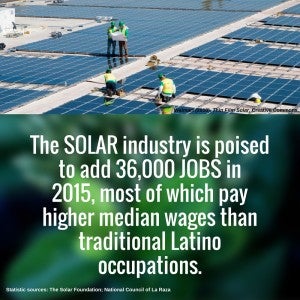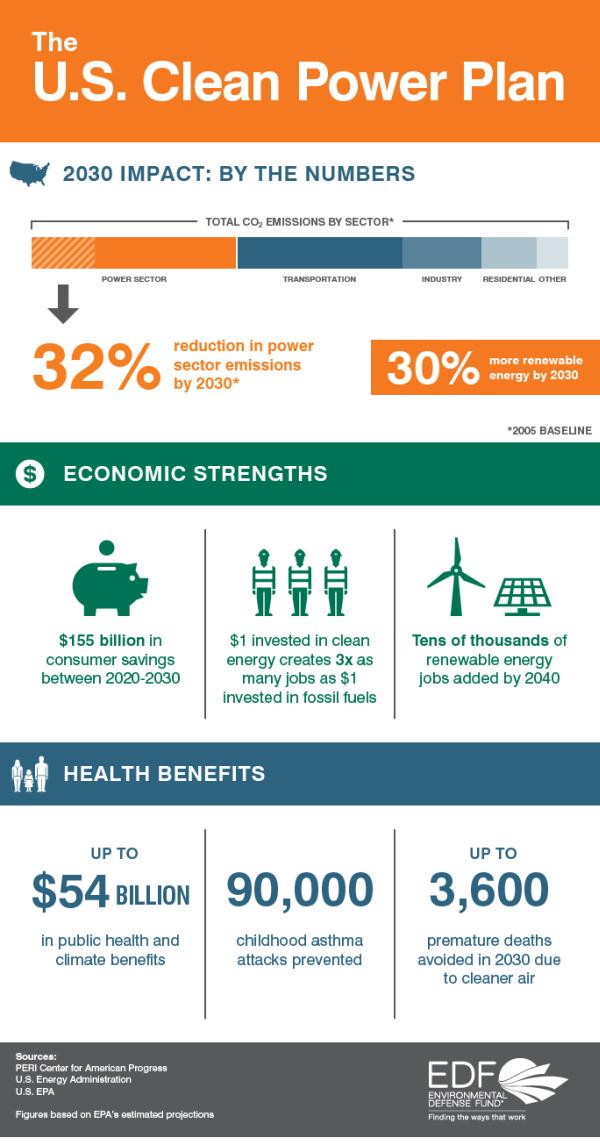The U.S. Environmental Protection Agency (EPA) will soon publish the Clean Power Plan in the Federal Register. The Clean Power Plan is a suite of historic Clean Air Act standards that will establish the first nationwide limits on carbon pollution from America’s fossil fuel-fired power plants.
Fossil fuel-fired power plants are the largest source of greenhouse gas emissions in the United States, accounting for almost 40 percent of the country’s carbon pollution. There is enormous potential for the power sector to reduce pollution by shifting to clean sources of energy – with immense benefits for the health of our families and communities, for creating jobs and strengthening the American economy, and for safeguarding our planet for our children. EPA projects that the Clean Power Plan will have total climate and public health benefits of up to $54 billion per year by 2030 – benefits that include saving up to 3,500 lives and avoiding 90,000 childhood asthma attacks each year.
These standards not only have huge benefits, they are eminently achievable. On a national basis, the power sector has already reduced carbon pollution emissions by 15 percent since 2005, a faster rate of reduction than the Clean Power Plan requires. Many states around the country are well on their way towards meeting the emission limits set forth in the Clean Power Plan, in large part due to policies and investment decisions that are already helping drive lower emissions. A recent analysis by EDF, for example, found that the state of Texas will achieve 88 percent of its Clean Power Plan target based solely on “business as usual” trends in the Texas power sector.
Like many recent Clean Air Act standards, the Clean Power Plan is likely to face a number of legal challenges from polluters and their allies who oppose reasonable limits on carbon pollution. A handful of premature legal challenges were filed before EPA even signed the final version the rule – challenges that were rejected by a unanimous three-judge panel of the U.S. Court of Appeals for the D.C. Circuit. A separate challenge brought by the State of Oklahoma was dismissed by an Oklahoma federal district court judge, and a related motion by Oklahoma to block the Clean Power Plan was denied by the U.S. Court of Appeals for the Tenth Circuit. And after EPA finalized the Clean Power Plan in August, several states and a major coal producer unsuccessfully sued to block the implementation of the rule.
Although more legal challenges will surely come upon the rule’s publication, the Clean Power Plan rests on a solid legal foundation and is wholly consistent with past Clean Air Act rules addressing the power sector – as many of the nation’s leading legal experts have noted since the Clean Power Plan was first proposed, including the author of section 111(d), numerous state Attorneys General, and the EPA General Counsel in the Bush administration.
EPA Has Clear Authority to Regulate Carbon Pollution from the Power Sector
EPA’s authority – and responsibility – to regulate carbon pollution from the power sector under the Clean Air Act is well-established. The Supreme Court has affirmed EPA’s authority to regulate greenhouse gases under the Clean Air Act three times since 2007. In American Electric Power v. Connecticut (2011), the Supreme Court specifically held that section 111(d) of the Clean Air Act – the provision that underlies the Clean Power Plan – “speaks directly” to the regulation of carbon pollution from existing power plants.
This conclusion was, in fact, stated before the Supreme Court by attorneys for some of the nation’s largest power companies – who declared unequivocally at oral argument that EPA has authority to regulate carbon pollution from the power sector under section 111(d):
“We believe that the EPA can consider, as it’s undertaking to do, regulating existing nonmodified sources under section 111 of the Clean Air Act, and that’s the process that’s engaged in now… Obviously, at the close of that process there could be APA challenges on a variety of grounds, but we do believe that they have the authority to consider standards under section 111.” – (Counsel for petitioners in AEP v. Connecticut)
In the lawsuits that were recently rejected by the D.C. Circuit court, coal companies and some states alleged that EPA is prohibited from regulating carbon pollution from the power sector – on the grounds that EPA is regulating mercury and other toxic pollutants from the power sector under a different section of the Clean Air Act. This “pick your poison” theory of the Clean Air Act not only ignores the Supreme Court’s ruling in AEP v. Connecticut, it rests on a selective and distorted reading of the law that ignores the Clean Air Act’s text, structure, and history.
The Clean Power Plan Rests on a Solid Legal and Technical Foundation
The Clean Power Plan is fully consistent with the “cooperative federalism” approach that EPA has applied under section 111(d) for nearly forty years, under which EPA issues minimum environmental standards that reflect the “best system of emission reduction” for existing sources, while giving states the opportunity to decide how best to meet those requirements through state plans.
In the Clean Power Plan, EPA has issued nationwide standards for carbon pollution from existing fossil fuel power plants – standards that are firmly grounded in proven, cost-effective technologies that power companies and states have already been successfully using to reduce carbon pollution, such as improving the efficiency of existing power plants and shifting generation to low or zero-emitting facilities. At the same time, the Clean Power Plan provides the states with tremendous flexibility in deciding how to achieve these targets – including the ability to use streamlined, highly cost-effective regulatory approaches similar to those used by EPA and the states under other successful Clean Air Act programs.
Opponents of the Clean Power Plan have made a host of hyperbolic claims about this common-sense approach, arguing that it amounts to a federal “takeover” of state energy policy and that it departs from the intent of the Clean Air Act. These claims are false.
Under EPA’s flexible approach, states can achieve the carbon pollution targets through streamlined, cost-effective air pollution regulations, such as emissions trading programs, that apply only to fossil fuel-fired power plants and that are compatible with a range of state energy policies. Ten states are already using such approaches to limit carbon pollution from power plants, and more than two dozen states are using such approaches to address sulfur dioxide and nitrogen oxide emissions from existing power plants under EPA’s Cross-State Air Pollution Rule – which was upheld by the U.S. Supreme Court in April 2014 against vigorous legal challenges.
EPA’s approach comports with the language of section 111(d), reflects approaches that states and power companies are already using to reduce carbon pollution, and is wholly consistent with other Clean Air Act programs for the power sector.
As required by the Clean Air Act, EPA also exhaustively analyzed the Clean Power Plan to ensure that it is based on the best available technical information and will not compromise the affordable, reliable supply of electricity. EPA’s review of the millions of comments it received on every aspect of the proposed version of the Clean Power Plan has only strengthened the technical foundations of the final rule.
Legal Experts Confirm the Strong Legal Basis for the Clean Power Plan
Many of the nation’s leading law enforcement officials, former EPA officials, and prominent legal scholars have concluded that the Clean Power Plan is firmly within EPA’s long-standing authority under the Clean Air Act.
A few illustrative statements include:
- “The Text, Structure, and History of the Clean Air Act Confirm EPA’s Authority to Regulate Carbon Dioxide Emissions from Power Plants Under Section 111(d).” — Attorneys General of the States of New York, California, Connecticut, Delaware, Maine, Maryland, Massachusetts, New Hampshire, New Mexico, Oregon, Rhode Island, Vermont, Washington, and the District of Columbia, in brief filed in Murray Energy Corp. v. Environmental Protection Agency, No. 14-1112 (D.C. Cir. Dec. 23, 2014)
- “The new rules set reasonable limits on emissions of climate change pollution from new and existing power plants and are firmly grounded in law.” — George Jepsen, Attorney General of Connecticut, Gov. Malloy, Attorney General Jepsen, Commissioner Klee Statements on EPA Rule on Pollution from Power Plants
- “The EPA has authority under the 1990 Clean Air Act, an authority affirmed by the U.S. Supreme Court, to set these public health protections against carbon pollution.” — Carol M. Browner, former EPA Administrator, and Alex Laskey, President & Founder, Opower, With New Power Plant Rules, Energy Efficiency Checks All the Boxes
- “Limiting Greenhouse Gas emissions from existing power plants is the next logical step after the Supreme Court and other courts have upheld EPA’s authority and obligation to address this issue. A system-wide approach provides needed flexibility and reduces costs, as well as encouraging investment in lower-emitting generation. EPA has wisely left the states a lot of discretion rather than mandating specific measures as some had wanted.” — E. Donald Elliott, EPA General Counsel under President George H.W. Bush, Obama’s Section 111d Plan Has Support From George H.W. Bush’s EPA General Counsel, Utility Executives
- “There is just case law building on case law that says, [the Clean Power Plan] is perfectly constitutional.” — Jody Freeman, Archibald Cox Professor of Law, Harvard Law School, Harvard Law’s Lazarus and Freeman discuss federal court Power Plan hearing, Tribe arguments
- “Clean Air Act regulations of existing power plants implemented by presidents of both parties over the past quarter of a century have achieved vitally important protections for public health and the environment through regulatory tools carefully designed to minimize costs. By following in the footsteps of earlier rules, the Clean Power Plan could be similarly transformative. The claim that it is unprecedented and unconstitutional is wrong on the facts and wrong on the law.” — Richard Revesz, Dean Emeritus and Lawrence King Professor of Law, NYU School of Law, Obama’s professor on Clean Power Plan – Wrong on the facts and law
- “[T]he EPA stands an excellent chance of prevailing in this epic showdown. And for the good of the planet and the welfare of future generations, one can only hope it will.” — Patrick Parenteau, Professor, Vermont Law School, The Clean Power Plan Will Survive: Part 2
- “[I]t is important to be clear here: the President is required to issue the rules, required by law and by the interpretation of the law by the highest Court in the land.” — Ann Carlson, Shirley Shapiro Professor of Environmental Law, UCLA School of Law, Obama Has to Issue Climate Change Rules — The Law Says So
Many experts have also concluded that requests for courts to block (or “stay”) the Clean Power Plan during the period of litigation are likely to fail:
- “I think the deadlines [in the Clean Power Plan] are sufficiently far in the future that there’s no need for a stay here, the court is certainly going to be able to decide this case before the deadlines.” — Robert Percival, Robert F. Stanton Professor of Law and Director, Environmental Law Program, University of Maryland, Francis King Carey School of Law, EPA, Clean Power Plan Foes Gird For Court Fight
- “[T]he EPA’s rule includes generous compliance deadlines . . . Challengers will be hard-pressed to persuade anyone they merit a stay.” — Jody Freeman, Archibald Cox Professor of Law, Harvard Law School, and Richard Lazarus, Howard and Katherine Aibel Professor of Law, Harvard University, The Biggest Risk to Obama’s Climate Plan May Be Politics, Not the Courts
EPA Has an Extensive Record of Success in Defending Clean Air Act Rules
Almost all of the major Clean Air Act rules that have so successfully protected human health and the environment in recent years have undergone intense legal challenges – and EPA has a great track record in defending these rules in the courts.
Consider these recent examples:
- EPA v. EME Homer City Generation (U.S. Supreme Court, 2014) — In a major victory for EPA, the Supreme Court reversed a D.C. Circuit decision invalidating the Cross-State Air Pollution Rule. In early 2015, the Cross-State Air Pollution Rule took effect in states across the Eastern United States – protecting millions of Americans from power sector emissions that contribute to harmful particulate matter and smog pollution.
- Utility Air Regulatory Group v. EPA (U.S. Supreme Court, 2014) — The Supreme Court upheld EPA’s interpretation of the Clean Air Act requiring that new and modified industrial facilities obtain permits limiting their emissions of greenhouse gases to reflect “best available control technology.” The Court did rule against EPA on the question of whether the “best available control technology” requirement applies to smaller facilities. However, EPA itself had concluded those requirements would pose serious practical problems and yield relatively small pollution control benefits.
- Coalition for Responsible Regulation v. EPA (D.C. Circuit, 2012) — The D.C. Circuit Court of Appeals upheld EPA’s science-based finding that climate pollution endangers public health and welfare, and EPA’s first generation of greenhouse gas emission standards for passenger vehicles. The Supreme Court declined to review either of these critical holdings, laying the groundwork for subsequent rules reducing greenhouse gas emissions from passenger vehicles and medium and heavy duty trucks.
- Delta Construction Co. v. EPA (D.C. Circuit, 2015) — The D.C. Circuit dismissed, on procedural grounds, multiple legal challenges to EPA’s first greenhouse gas standards for medium and heavy duty vehicles.
- National Association of Manufacturers v. EPA (D.C. Circuit, 2014) — EPA fended off challenges to the National Ambient Air Quality Standards for particulate matter (better known as soot).
The health and environmental benefits of the Clean Power Plan will be invaluable. As EPA prepares for the inevitable legal attacks, it has a strong legal foundation and a track record of litigation success.















